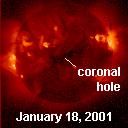|   SPACE WEATHER SPACE WEATHER
Current
Conditions
Solar Wind
velocity: 326.1 km/s
density:9.5 protons/cm3
explanation | more data
Updated: Today at 2245 UT
X-ray Solar Flares
6-hr max: M1 1730 UT Jan19
24-hr: M1 1730 UT Jan19
explanation | more data
Updated: Today at 2245 UT
Daily Sun: 19 Jan '01 
The largest spot on the Sun's visible disk is active region 9313, emerging now around the southeast limb.
Sunspot Number: 99
More about sunspots
Updated: 18 Jan 2001
Radio Meteor Rate
24 hr max: 50 per hr
Listen to the Meteor Radar!
Updated: 19 Jan 2001 Interplanetary Mag. Field
Btotal: 4.9 nT
Bz: 2.5 nT north
explanation | more data
Updated: Today at 2247 UT Coronal Holes:

A small coronal hole is crossing the center of the Sun's disk. Image credit: Yohkoh Soft X-ray Telescope.
More about coronal holes
 SPACE WEATHER SPACE WEATHER
NOAA
Forecasts
Solar Flares: Probabilities for a medium-sized (M-class) or a major (X-class) solar flare during the next 24/48 hours are tabulated below.
Updated at 2001 Jan 19 2200 UT
| FLARE | 24 hr | 48 hr | | CLASS M | 30 % | 30 % | | CLASS X | 05 % | 05 % |
Geomagnetic Storms: Probabilities for significant disturbances in Earth's magnetic field are given for three activity levels: active, minor storm, severe storm
Updated at 2001 Jan 19 2200 UT Mid-latitudes | 24 hr | 48 hr | | ACTIVE | 10 % | 10 % | | MINOR | 05 % | 05 % | | SEVERE | 01 % | 01 % |
High latitudes | 24 hr | 48 hr | | ACTIVE | 25 % | 25 % | | MINOR | 10 % | 10 % | | SEVERE | 01 % | 01 % |
| What's Up in Space -- 19 Jan 2001
Subscribe to Space Weather News! SOLAR FLARE: On Friday at 1730 UT an M1-class solar flare triggered minor radio blackouts on Earth. SOHO coronagraphs reveal a coronal mass ejection billowing away from eastern limb of the Sun, where the flare presumably occurred. Stay tuned for details.  EARTH SONGS: If humans had radio antennas instead of ears, we would hear a remarkable symphony of strange noises coming from the space around our own planet. An online receiver at the Marshall Space Flight Center is playing these elusive songs of Earth so anyone can listen. [FULL STORY] EARTH SONGS: If humans had radio antennas instead of ears, we would hear a remarkable symphony of strange noises coming from the space around our own planet. An online receiver at the Marshall Space Flight Center is playing these elusive songs of Earth so anyone can listen. [FULL STORY]
GLANCING IMPACT: An interplanetary shock wave buffeted Earth's magnetosphere on January 17th at 1600 UT. The disturbance was probably the outer fringe of a coronal mass ejection (CME) that billowed away from the Sun last Sunday after a solar filament collapsed. The bulk of the CME was directed away from Earth and, as expected, Wednesday's impact was only a glancing blow.  WEB LINKS: NOAA FORECAST | GLOSSARY | SPACE WEATHER TUTORIAL | LESSON PLANS | MORE NEWS | BECOME A SUBSCRIBER |
 - TOTAL LUNAR ECLIPSE: On Jan. 9, 2001, the full Moon glided through Earth's copper-colored shadow. [gallery]
- CHRISTMAS ECLIPSE: Sky watchers across North America enjoyed a partial solar eclipse on Christmas Day 2000 [gallery]
- LEONIDS 2000: Observers around the globe enjoyed three predicted episodes of shooting stars. [gallery]
 | NEAR-EARTH ASTEROID: On January 5th, MIT's LINEAR program spotted a new asteroid, 2001 AV43, one week after the space rock flew by Earth at a distance of 0.009 AU. With a diameter of about 60m, 2001 AV43 is too small to be considered a Potentially Hazardous Asteroid. The asteroid is notable, however, because it appears to follow a low inclination orbit that brings it about 0.5 lunar distances from Earth's orbit every 1.4 years. 2001 AV43 also experiences close encounters with Mars. |  Jan. 4, 2001: Earth at Perihelion -- On January 4, 2001, our planet made its annual closest approach to the Sun. Dec. 29, 2000: Millennium Meteors -- North Americans will have a front-row seat for a brief but powerful meteor shower on January 3, 2001. Dec. 28, 2000: Galileo Looks for Auroras on Ganymede -- NASA's durable Galileo spacecraft flew above the solar system's largest moon this morning in search of extraterrestrial "Northern Lights" Dec. 22, 2000: Watching the Angry Sun -- Solar physicists are enjoying their best-ever look at a Solar Maximum thanks to NOAA and NASA satellites. Dec. 18, 2000: Ursid Meteor Surprise -- The normally meek Ursid meteor shower could surprise sky watchers with a powerful outburst on Dec 22nd. Dec. 8, 2000: The Baffling Geminid Meteor Shower -- Most meteor showers are caused by comets, but the Geminids, which peak on December 13th, seem to come from a curious near-Earth asteroid. Nov. 22, 2000: A Solar Flare Stuns Stardust -- Earlier this month an intense solar radiation storm temporarily blinded NASA's Stardust spacecraft en route to comet Wild-2. Nov. 21, 2000: Leonids Galore -- Find out what happened during the 2000 Leonids meteor shower. Nov. 7, 2000: Much Ado about 2000 SG344 -- In 2071 a relic of NASA's earliest space exploration efforts might return to Earth, if current estimates are confirmed. Oct. 26, 2000: Lunar Leonids -- On Nov. 17, 2000, the moon will plow through a stream of debris from comet Tempel-Tuttle. Oct. 10, 2000: The Moonlit Leonids 2000 -- Our planet is heading for a minefield of cosmic dust streams laid down by periodic comet Tempel-Tuttle. The result could be a series of meteor outbursts on Nov. 17 and 18, 2000. MORE SPACE WEATHER HEADLINES |



